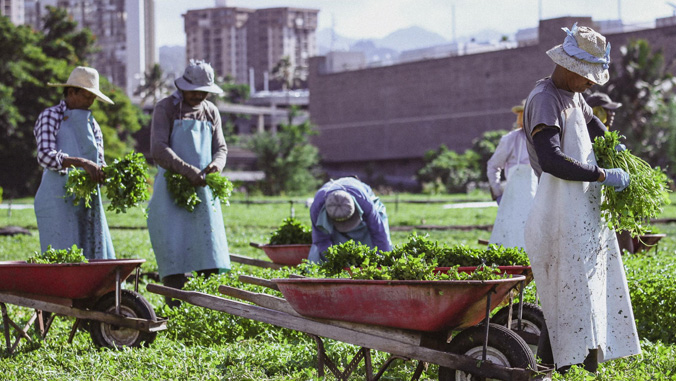
Once a preferred swimming pool of Hawaiian aliʻi, the Kalauao Spring on the island of Oʻahu continues to supply millions of gallons of clean, fresh water to the Pearl Harbor region. Today, changes to the environment, climate and continued development of the surrounding areas have called into question its sustainability.
The findings are part of research by University of Hawaiʻi at Mānoa researchers and Sumida Farm farmers, detailing their collaboration to examine the past, present and future of the multigenerational farm which produces 70 percent of Hawaiʻi’s watercress. The study highlights that relationships with the broader community have enhanced Sumida Farm’s ability to adapt and innovate their farm practices in response to challenges and changing conditions.
Third-generation farmers, siblings Barbara and David Sumida had been running the farm for decades, and were starting to wonder if the clean fresh spring water that was the source of their livelihood was experiencing pollution from the surrounding urban development; if the springs were getting saltier from sea level rise; and why the crops were dying off during the hottest summer months.
In 2017, the Sumida family began to collaborate with members of UH Mānoa’s ʻIke Wai research group. A team of UH earth scientists, economists, geographers and Hawaiian language experts, and the Sumida family used novel research methods to study this dynamic and fragile resource and investigate changes they were observing in the crops.

- Related UH News story: Study predicts costly water issues if action not taken, July 16, 2020
History of Sumida Farm
The team pursued an approach that included interviews about farm history and harvests; place name searches to research the moʻolelo (stories) of Kalauao (Kahuawai) Spring; a 25-year retrospective analysis of harvests, groundwater pumping, Oceanic Niño Index and temperature to identify trends in productivity; a one-year intensive study of the freshwater springs at the farm to identify any seasonal, tidal and climate-induced changes to water quality, as well as pollution from agriculture or cesspools; and an analysis of local and national press to determine the community’s valuation of the farm over its 90-year history.
“This deep dive into the history of the farm uncovered some very surprising insights,” said Jennifer Engels, affiliate researcher with UH Mānoa’s School of Ocean and Earth Science and Technology (SOEST) and lead author of the study. “The close partnership between the UH Mānoa team and the Sumidas resulted in a great synergy of ideas and information that would never have been possible without their generational accounts of lived experiences on the farm.”
The team sought to gain insight into the resilience of the Sumidas’ watercress farm despite the pressures of urbanization that have made other small farms obsolete around the islands.
It turns out that thousands of community members, from school children to senior citizens to celebrity chefs, have been welcomed to Sumida Farm over the past several decades—creating deep and meaningful connections. Furthermore, as far back as the 1800s, many accounts from Hawaiian language newspaper reports indicate how valuable and useful the spring and the surrounding areas were for the community.
“Hawaiʻi has ambitious goals around food sustainability by 2050, and yet small farms around the state have struggled or failed over the last several decades,” said Engels. “Sumida Farm has survived and thrived despite multiple challenges throughout its history, from pests, to urbanization, to climate change. Their example can serve as a model for other small farms.”
For more see SOEST’s website.
—By Marcie Grabowski

